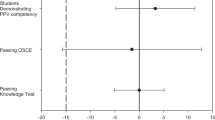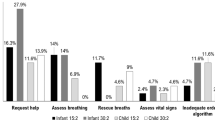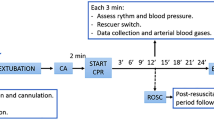Abstract
Objective:
Providing adequate bag-mask ventilation (BMV) is an essential skill for neonatal resuscitation. Often this skill is learned using simulation manikins. Currently, there is no means of measuring the adequacy of ventilation in simulated scenarios. Thus, it is not possible to ascertain proficiency. The first aim of this study was to measure the pressure generated during BMV as performed by providers with different skill levels and measure the impact of different feedback mechanisms. The second aim was to measure the pressure volume characteristics of two neonatal manikins to see how closely they reflect newborn lung mechanics.
Study Design:
In Phase I to achieve the first aim, we evaluated BMV skills in different level providers including residents (n=5), fellows (n=5), neonatal nurse practitioners (n=5) and neonatologists (n=5). Each provider was required to provide BMV for 2-min epochs on the SimNewB (Laerdal), which had been instrumented to measure pressure-volume characteristics. In sequential 2-min epochs, providers were given different feedback including chest-wall movement alone compared to manometer plus chest-wall movement or chest-wall movement plus manometer plus laptop lung volume depiction. In Phase II of the study we measured pressure-volume characteristics in instrumented versions of the SimNewB (Laerdal) and NeoNatalie (Laerdal).
Results:
In Phase I, all providers are compared with the neonatologists. All measurements of tidal volume (Vt) are below the desired 5 ml kg−1. The greatest difference in Vt between the neonatologists and other providers occurs when only chest-wall movement is provided. A linear relationship is noted between Vt and PIP for both SimNewB and NeoNatalie. The compliance curves are not ‘S-shaped’ and are different between the two models (P<0.001).
Conclusion:
Phase I of this study demonstrates that the SimNewB with the feedback of chest-wall movement alone was the best method of distinguishing experienced from inexperienced providers during simulated BMV. Therefore this is likely to be the best method to ascertain proficiency. Phase II of the study shows that the currently available neonatal simulation manikins do not have pressure-volume characteristics that are reflective of newborn lung mechanics, which can result in suboptimal training.
This is a preview of subscription content, access via your institution
Access options
Subscribe to this journal
Receive 12 print issues and online access
$259.00 per year
only $21.58 per issue
Buy this article
- Purchase on Springer Link
- Instant access to full article PDF
Prices may be subject to local taxes which are calculated during checkout




Similar content being viewed by others
References
Levine AI, Schwartz AD, Bryson EO, DeMaria S . Role of simulation in US physician licensure and certification. Mt Sinai J Med 2012; 79: 140–153.
Steadman RH, Huang YM . Simulation for quality assurance in training, credentialing and maintenance of certification. Best Pract Res Cl Anaethesiol 2012; 26: 3–15.
Norcini JJ, Lipner RS, Grosso LJ . Assessment in the context of licensure and certification. Teach Learn Med 2013; 25: S62–S67.
Gallager CJ, Tan JM . The current status of simulation in the maintenance of certification in anesthesia. Int Anesthesiol Clin 2010; 48: 83–99.
Kattwinkel J . Textbook of Neonatal Resuscitation, 6th edn. Amer Academy of Pediatrics and American Heart Association: Chicago, IL, USA, 2011.
Krauss B, Green SM . Training and credentialing in procedural sedation and analgesia in children: lessons from the United States model. Ped Anesth 2008; 18: 30–35.
O’Connor RE, Sama A, Burton JH, Callahan ML, House HR, Jaquis WP et al. Procedural sedation and analgesia in the Emergency Department: Recommendations for Physician Credentialing, Privileging and Practice. Ann Emerg Med 2011; 58: 365–370.
Caperelli-White L, Urman RD . Developing a moderate sedation policy: essential elements and evidence-based considerations. AORN J 2014; 99: 416–430.
McGaghie WC, Issenberg SB, Petrusa ER, Scalese RJ . A critical review of simulation-based medical education research: 2003–2009. Med Educ 2010; 44: 50–63.
Singhal N, Lockyer J, Fidler H, Keenan W, Little G, Bucher S et al. Helping babies breathe: global neonatal resuscitation program development and formative educational evaluation. Resuscitation 2012; 83: 90–96.
Curtis MT, DiazGranados D, Feldman M . Judicious use of simulation technology in continuing medical education. J Contin Educ Health Prof 2012; 32: 255–260.
Hamstra SJ, Brydges R, Hatala R, Zendejas B, Cook DA . Reconsidering fidelity in simulation-based training. Acad Med 2014; 89: 387–392.
McGaghie WC, Issenberg SB, Cohen ER, Barsuk JH, Wayne DB . Does simulation based medical education with deliberate practice yield better results that traditional clinical education? A meta-analytic comparative review of evidence. Acad Med 2011; 86: 706–711.
Scalese RJ, Obeso VT, Issenberg SB . Simulation technology for skills training and competency assessment in medical education. JGIM 2008; 23: 46–49.
Ziv A, Ben-David S, Ziv M . Simulation based medical education: an opportunity to learn from errors. Med Teach 2005; 27: 193–199.
ACGME Requirements for Graduate Medical Education in Pediatrics. Available at https://www.acgme.org/acgmeweb/Portals/0/PFAssets/2013-PR-FAQ-PIF/320_pediatrics_07012013.pdf (last accessed 21 February 2015).
Lane JL, Slavin S, Ziv A . Simulation in medical education: a review. Simulat Gaming 2001; 32: 297–314.
O’Donnell CPF, Davis PG, Morley CJ . Positive pressure ventilation at neonatal resuscitation: review of equipment and international survey of practice. Acta Paediatr 2004; 93: 583–588.
Bennett S, Finer NN, Rich W, Vaucher Y . A comparison of three neonatal resuscitation devices. Resuscitation 2005; 67: 113–118.
Author information
Authors and Affiliations
Corresponding author
Ethics declarations
Competing interests
The authors declare no conflict of interest.
Rights and permissions
About this article
Cite this article
Pearlman, S., Zern, S., Blackson, T. et al. Use of neonatal simulation models to assess competency in bag-mask ventilation. J Perinatol 36, 242–246 (2016). https://doi.org/10.1038/jp.2015.175
Received:
Revised:
Accepted:
Published:
Issue Date:
DOI: https://doi.org/10.1038/jp.2015.175



